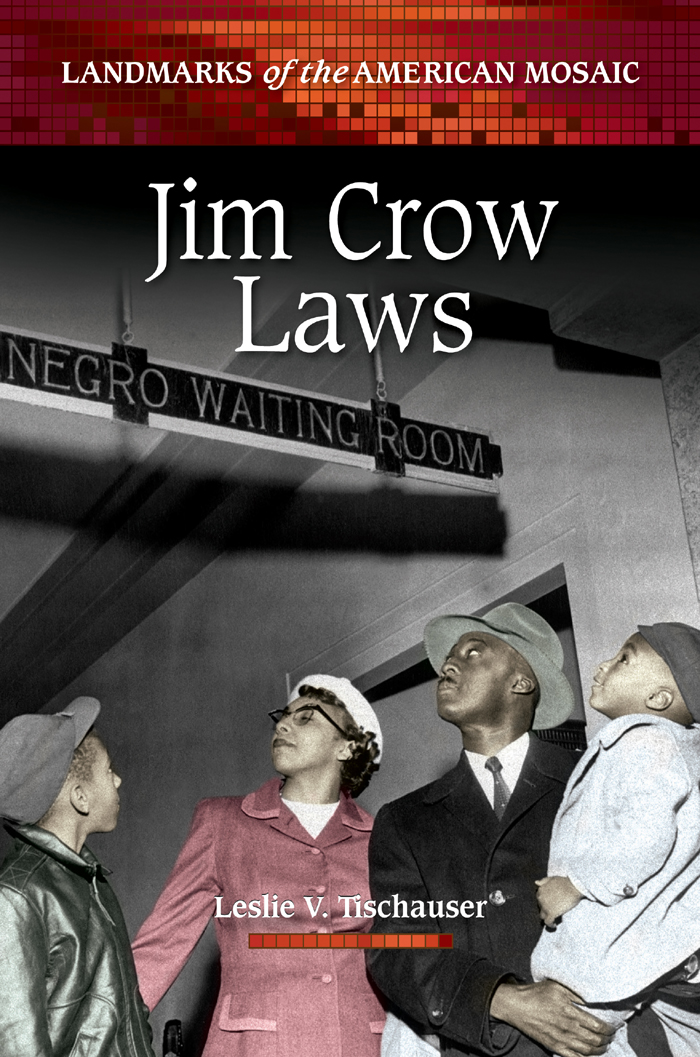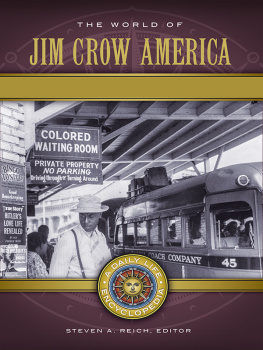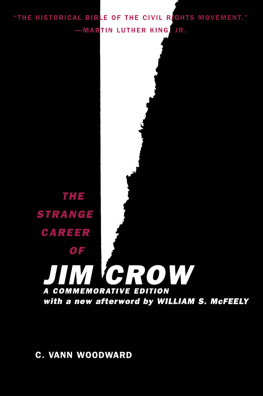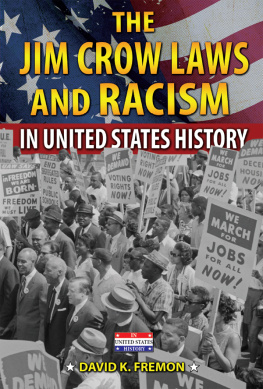Leslie Tischauser - Jim Crow Laws
Here you can read online Leslie Tischauser - Jim Crow Laws full text of the book (entire story) in english for free. Download pdf and epub, get meaning, cover and reviews about this ebook. year: 2012, publisher: Greenwood, genre: Politics. Description of the work, (preface) as well as reviews are available. Best literature library LitArk.com created for fans of good reading and offers a wide selection of genres:
Romance novel
Science fiction
Adventure
Detective
Science
History
Home and family
Prose
Art
Politics
Computer
Non-fiction
Religion
Business
Children
Humor
Choose a favorite category and find really read worthwhile books. Enjoy immersion in the world of imagination, feel the emotions of the characters or learn something new for yourself, make an fascinating discovery.

- Book:Jim Crow Laws
- Author:
- Publisher:Greenwood
- Genre:
- Year:2012
- Rating:3 / 5
- Favourites:Add to favourites
- Your mark:
- 60
- 1
- 2
- 3
- 4
- 5
Jim Crow Laws: summary, description and annotation
We offer to read an annotation, description, summary or preface (depends on what the author of the book "Jim Crow Laws" wrote himself). If you haven't found the necessary information about the book — write in the comments, we will try to find it.
Jim Crow Laws — read online for free the complete book (whole text) full work
Below is the text of the book, divided by pages. System saving the place of the last page read, allows you to conveniently read the book "Jim Crow Laws" online for free, without having to search again every time where you left off. Put a bookmark, and you can go to the page where you finished reading at any time.
Font size:
Interval:
Bookmark:

Leslie V. Tischauser
ABC-CLIO, LLC
Copyright 2012 by ABC-CLIO, LLC
All rights reserved. No part of this publication may be reproduced, stored in a
retrieval system, or transmitted, in any form or by any means, electronic,
mechanical, photocopying, recording, or otherwise, except for the inclusion of
brief quotations in a review, without prior permission in writing from the
publisher.
Library of Congress Cataloging-in-Publication Data
Tischauser, Leslie Vincent, 1942
Jim Crow laws / Leslie V. Tischauser.
p. cm. (Landmarks of the American mosaic)
Includes bibliographical references and index.
ISBN 9780313386084 (hardcopy : alk. paper) ISBN 9780313386091 (ebook) 1. African AmericansLegal status, laws, etc.History. 2. Race discriminationLaw and legislationUnited StatesHistory. 3. African AmericansSocial conditionsTo 1964. I. Title.
KF4757.T57 2012
342.730873dc23 2012007814
ISBN: 9780313386084
EISBN: 9780313386091
1615141312 12345
This book is also available on the World Wide Web as an eBook.
Visit www.abc-clio.com for details.
Greenwood
An Imprint of ABC-CLIO, LLC
ABC-CLIO, LLC
130 Cremona Drive, P.O. Box 1911
Santa Barbara, California 93116-1911
This book is printed on acid-free paper
Manufactured in the United States of America
The Landmarks of the American Mosaic series comprises individual volumes devoted to exploring an event or development central to this countrys multicultural heritage. The topics illuminate the struggles and triumphs of American Indians, African Americans, Latinos, and Asian Americans, from European contact through the turbulent last half of the twentieth century. The series covers landmark court cases, laws, government programs, civil rights infringements, riots, battles, movements, and more. Written by historians especially for high school students on up and general readers, these content-rich references satisfy more thorough research needs and provide a deeper understanding of material that students might only otherwise be exposed to in a short section in a textbook or superficial explanation online.
Each book on a particular topic is a one-stop reference source. The series format includes:
- Introduction
- Chronology
- Narrative chapters that trace the evolution of the event or topic chronologically
- Biographical profiles of key figures
- Selection of crucial primary documents
- Glossary
- Bibliography
- Index
This landmark series promotes respect for cultural diversity and supports the social studies curriculum by helping students understand multicultural American history.
This book is presented as a reference work for students and general readers. Its purpose is to provide a chronological history of racial segregation in the United States from the end of the Civil War to the passage of the 1964 Civil Rights Act. The book includes biographies of key figures in the campaign against legal segregation, key documents presenting arguments for and against equal rights for all Americans, a glossary explaining the meaning of unfamiliar terms, and a bibliography assessing the important books on the topic and listing electronic resources suitable for student researchers. The major portion of this book describes the methods, purposes, and attitudes that created a legal system that separated people by race in schools, courthouses, busses, trains, and other public places where people might meet in more than one-half of American states. It also describes the legal strategies, demonstrations, marches, protests, and political activities that were used by supporters of equal rights for all Americans. Those combined actions eventually overturned the Jim Crow system. The fight against the legal segregation (which the Supreme Court declared constitutional in 1896) was long, bitter, many times violent, but eventually successful. The defeat of Jim Crow represented a victory for equal rights for all Americans. This is the story of that long struggle and its final victory.
I would like to acknowledge the help and assistance provided by my wife and best friend, Connie, and my sons Jeffrey and Michael. Without their encouragement and support this book would have been much more difficult to write and complete. And to the nurses and doctors in the intensive care unit at West Suburban Hospital, I offer my utmost thanks because without their dedication, kindness, and professionalism this book would never have been completed.
From 1881 to 1964, Jim Crow laws separated Americans by race in 26 states. The laws created de jure segregation or the legal separation by race of Americans. In most American cities, towns, and states, North and South, people lived in segregated neighborhoods and attended schools that were all white or all black. However, attitudes and history, not laws, created that separation or de facto segregation. The majesty of the law stood behind legal segregation in Jim Crow states. The rule of law imposed penalties and punishments on people who broke those statutes and ordinances mandating segregation. The most common Jim Crow laws made it illegal for anyone to marry someone of another race and demanded that business owners separate their customers by skin color and protected their right to legally refuse service to people because of their race.
Jim Crow America included the eleven states that seceded from the Union in 1861 and established the Confederate States of America. The Confederate states had one goal in mind when they broke away from the Union, the preservation of slavery and white supremacy. Abraham Lincoln went to war to preserve the Union and to end slavery. The Thirteenth Amendment added to the Constitution after the Civil War ended slavery in the United States. It had little impact on the attitudes and ideas used to defend and support the idea that holding other people as property and denying them freedom and any thoughts of equality was justified. Jim Crow laws were aimed at denying freedom and equality to the same group that had been enslaved, African Americans.
One idea topped all others, the supremacy of the white race, and in the racist mind it justified the abuse and inhuman treatment suffered for generations by Africans in the United States. If Africans were not human, or if they were an inferior or lesser part of the human race, they did not have to be treated like human beings. They did not have human rights because they were not part of humanity. They were cannibals, savages, and alien creatures coming straight out of the jungle. Biologically they stood closer to gorillas and apes than to human beings. The savagery and barbarism they had inherited from their ancestors for hundreds of years justified their enslavement. Their violent and murderous natures were not easily controlled. The chains of slavery were all that kept Africans from murdering white men and raping their wives and daughters.
The Civil War ended slavery and freed the slaves in the United States, but for most white Southerners, the war had ended nothing. Africans were not ready or able to live freely without the restraints offered by enslavement. They needed discipline and self-control before they could live freely next to whites, but preferably as far away from whites as possible. Without self-discipline and the ability to control their passions (mainly their sexual instincts), the freed blacks would unleash a campaign of violence, murder, and death such as the South had never before seen. The goal of Jim Crow laws was to create a legal system that offered the same protections against black beastliness, that had been established by slave codes. Instead of chains, whips, and deadly fear, however, laws, jails, powerlessness, and the constant fear of death would provide those protections. Harsh laws separating blacks from whites, always backed up by fear of a lynch mob, a beating, or a severe, pain-filled punishment, would keep blacks from ever coming close to achieving equality. Demanding that black children go to separate schools than whites or that blacks not use the same washroom that whites used, or enter a building or room by a separate dooralways in the backwas part of Gods law, it was part of the natural order of the universe. Breaking those laws would destroy that entire universe and way of life, the southern way of life, which outsiders never understood. For much of its history Jim Crow segregation had the protection of the U.S. Constitution and U.S. Supreme Court.
Font size:
Interval:
Bookmark:
Similar books «Jim Crow Laws»
Look at similar books to Jim Crow Laws. We have selected literature similar in name and meaning in the hope of providing readers with more options to find new, interesting, not yet read works.
Discussion, reviews of the book Jim Crow Laws and just readers' own opinions. Leave your comments, write what you think about the work, its meaning or the main characters. Specify what exactly you liked and what you didn't like, and why you think so.




